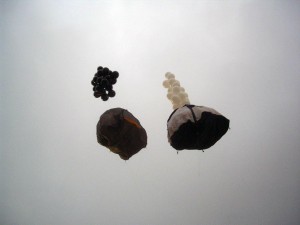 #Occupy. Where does it go from here? How ‘bout up? I’m not 100% serious, but it’s been fascinating to see how #Occupy has expanded occupation to mean more than parking our collective butts on a flat—or at least, horizontal—and usually (so far) outdoor surface. We geographers like to hammer on about how social spaces are so damn hypercomplex, but serious examination of spatiality often sidesteps the volumetric, the aerial, the vertical, the subterranean, and the ever finicky hydrological—particularly, when it comes to the sea. Lucky for us, these sometimes-overlooked aspects of spatiality have been subject to increasingly critical scrutiny by the geographically inclined. What makes volume, the aerial, and the vertical such powerful vehicles of protest is that they jarringly dethrone common sense understandings of space as two-dimensional and material.
#Occupy. Where does it go from here? How ‘bout up? I’m not 100% serious, but it’s been fascinating to see how #Occupy has expanded occupation to mean more than parking our collective butts on a flat—or at least, horizontal—and usually (so far) outdoor surface. We geographers like to hammer on about how social spaces are so damn hypercomplex, but serious examination of spatiality often sidesteps the volumetric, the aerial, the vertical, the subterranean, and the ever finicky hydrological—particularly, when it comes to the sea. Lucky for us, these sometimes-overlooked aspects of spatiality have been subject to increasingly critical scrutiny by the geographically inclined. What makes volume, the aerial, and the vertical such powerful vehicles of protest is that they jarringly dethrone common sense understandings of space as two-dimensional and material.
Occupy Cal: Volume
I was first struck by the brilliance of occupying volume when the OccupyCal encampment at UC Berkeley was violently destroyed by club-wielding police on November 9. County sheriffs brutally beat down non-violent protests on the Mario Savio Steps named after a leader of Berkeley’s 1960s Free Speech Movement. Savio gave his famous Machine Speech on those steps. The UC administration justified the beating saying that camping is not allowed on campus—surely, there’s an etymological contradiction in terms in there somewhere. The Suits in the administration ridiculously added the linked arms of peaceful protestors constituted a “not non-violent” action.
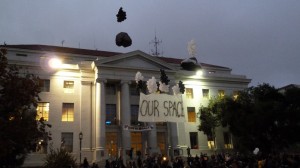 Promising to defy the administration’s no-tent order, students started stuffing tents with helium balloons, stringing up a banner, and letting ‘em fly over the Mario Savio Steps in Sproul Plaza. The radical history of this space along with the concomitant and long-standing repressive nature of UC administors was put on brilliant display—quite literally—in space.
Promising to defy the administration’s no-tent order, students started stuffing tents with helium balloons, stringing up a banner, and letting ‘em fly over the Mario Savio Steps in Sproul Plaza. The radical history of this space along with the concomitant and long-standing repressive nature of UC administors was put on brilliant display—quite literally—in space.
It’s worth remembering that one reason why the UC administration is so violently against any kind of permanent spatial occupation is because of its being overpowered by events like “Peoples’ Park” (still there) and the “Oak Grove Tree Sitters” (lasted two years). Tents, which are volume-with-a-purpose, have helped sustain outdoorsy occupations around the world and, like pepper-spray, have become an instigating motif of #Occupy.
NYC: Verticality
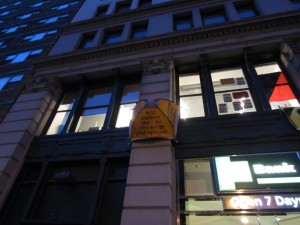 Then came news from what comes closest to being my hometown: New York City. Bajillionaire Mayor Michael Bloomberg had violently evicted protestors from Zuccotti Park, the “privately owned public space” that became #Occupy’s Mother ship. (FYI: Mr. Money Bags’ romantic squeeze—Diana L. Taylor—sits on the park’s Board of Directors. Just sayin’.) As Gastón Gordillo put it in a recent essay, Zuccotti is a “public space under corporate sovereignty.”
Then came news from what comes closest to being my hometown: New York City. Bajillionaire Mayor Michael Bloomberg had violently evicted protestors from Zuccotti Park, the “privately owned public space” that became #Occupy’s Mother ship. (FYI: Mr. Money Bags’ romantic squeeze—Diana L. Taylor—sits on the park’s Board of Directors. Just sayin’.) As Gastón Gordillo put it in a recent essay, Zuccotti is a “public space under corporate sovereignty.”
Ousted from Zuccotti, students at The New School occupied portions of a university study center at 90 5th Ave. The kicker? This building in the heart of the Village is technically owned by the foreclose-the-crap-out-of-you behemoth known as Wells Fargo. But something caught my eye in the photos posted online. Next to a big banner announcing “The Zuccotti Virus has Spread” was a small tent hanging on the side of the building. Dubbed by some a “mili-tent,” this vertically hanging volume-with-a-purpose was scrawled with a heart-warming message for Mr. Money Bags: “You cannot evict an idea whose time has come.” Occupy Verticality.
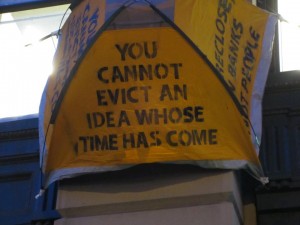 The tent hung there like a determined mosquito on a towering materialization of capital. Gordillo contrasts his rhizomatic exposé of #Occupy, with the phallic and arrogant verticality of NYC’s shiny corporate skyscrapers and the two-dimensional god’s-eye trick of the state. The hanging tent seems to enact a similar critique. I doubt that the thousand little pin pricks of mili-tent mosquitos is enough to bring down the giant, but we can at least annoy the hell out of it.
The tent hung there like a determined mosquito on a towering materialization of capital. Gordillo contrasts his rhizomatic exposé of #Occupy, with the phallic and arrogant verticality of NYC’s shiny corporate skyscrapers and the two-dimensional god’s-eye trick of the state. The hanging tent seems to enact a similar critique. I doubt that the thousand little pin pricks of mili-tent mosquitos is enough to bring down the giant, but we can at least annoy the hell out of it.
More Volume! Oh, and Drones
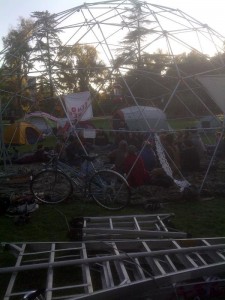 Meanwhile, back on the West Coast, “not non-violent” protestors at UC Davis were being chemically drenched by the armed-wing of the UC administration. The now-famous incident was brought you courtesy of Sgt. Pepper (aka Lt. Pike) and Chancellor Linda Katehi. Again, UC students did not back down and the next day they re-established their camp and upped the ante: A geodesic dome. Picture it: “I know what this protest needs… More volume!” Whose dome?! Our dome! Once again, space for #Occupy is much more than a two-dimensional squat.
Meanwhile, back on the West Coast, “not non-violent” protestors at UC Davis were being chemically drenched by the armed-wing of the UC administration. The now-famous incident was brought you courtesy of Sgt. Pepper (aka Lt. Pike) and Chancellor Linda Katehi. Again, UC students did not back down and the next day they re-established their camp and upped the ante: A geodesic dome. Picture it: “I know what this protest needs… More volume!” Whose dome?! Our dome! Once again, space for #Occupy is much more than a two-dimensional squat.
Finally, on the aerial front: #Occupy could use some drones. Geographically inclined scholars from Derek Gregory to Eyal Weizman, have done great critical work on the drone wars. Weizman has done brilliant work disentangling how expansive conceptions and uses of spatiality have been mobilized by Israeli occupation producing “politics in matter.” But, as we know, power and space swing both ways. That’s why we need more drones. Aerogeography brought to you by DIY drone.
It’s the ultimate anti-kettle device. Check out this video (h/t Danger Room) from our comrades in Poland:
[youtube_sc url=”http://youtu.be/9vOor1xmVDs”]

Great piece. We indeed need more studies of the three-dimensional spatial forms that make up any territorial configuration. Eyal Weizman -not surprisingly an architect who has read Deleuze and Guattari carefully- is certainly a key source here.
My main comment is that the undoubtedly brilliant use of verticality by the occupy movement in the first examples (the flying tents at UC berkeley, etc.) nonetheless represents a retreat of sorts: an admission that the state has re-asserted its control of the streets. And let’s not forget that those are empty tents, a hollow volume without human bodies.
The drone in Poland, however, is to me politically more effective and much more interesting, because it creates something quite unique: a vertical and mobile field of vision at the service of anti-capitalist protests. Thus far, the state-capitalist machine has almost absolute control over vertical fields of vision. Historically, the political importance of verticality has been that the higher up you go the larger and wider your field of vision: tops of mountains in the past and satellites and drones in the present allow you to see what’s going on and the spatial location of your adversaries-enemies. Hence the importance of creating non-state drones with vertical fields of vision that as in Poland allow the multitude to see how the state is maneuvering to occupy the streets.
I’ll post an entry on my blog on this same topic soon. regards
One thing that struck me about Weizman’s book was learning about IDF strategists also reading D&G really closely–frightening.
Good points about the hollow tents, which was admittedly a floating tactical retreat.
I’m really concerned with the critical question that remains: What to do without encampments? How will this new conjuncture steer #Occupy?
Pingback: The aesthetics of protest: how Occupy sees itself (continually updated post—last update: December 19, 2011) « typologica
Pingback: The New Aesthetic Part II: Writing Like A Drone | Territorial Masquerades
Pingback: The aesthetics of protest: how Occupy sees itself (chapter one) | TYPOLOGY
Pingback: TYPOLOGY | The aesthetics of protest: how Occupy sees itself (chapter one)